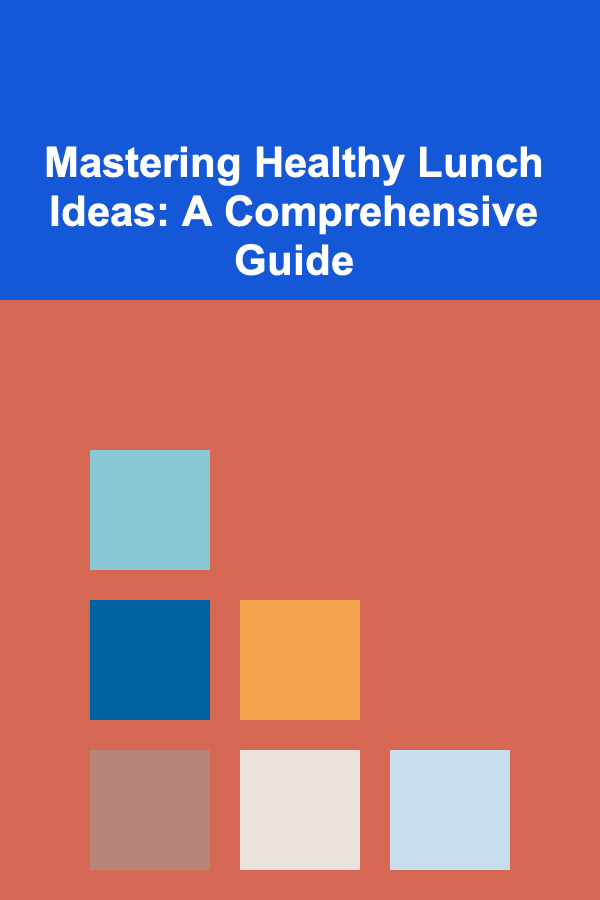
Mastering Healthy Lunch Ideas: A Comprehensive Guide
ebook include PDF & Audio bundle (Micro Guide)
$12.99$11.99
Limited Time Offer! Order within the next:

The Importance of a Healthy Lunch
In the hustle and bustle of modern life, lunch often becomes an afterthought. Many resort to quick, convenient, and often unhealthy options like fast food, processed snacks, or skipping the meal altogether. However, a nutritious and balanced lunch plays a crucial role in our overall well-being. It's not just about satiating hunger; it's about fueling our bodies and minds for optimal performance throughout the afternoon.
Think of lunch as the midday reset button. After a morning of activity, whether it's physical labor, mental exertion, or a combination of both, our energy levels naturally start to dip. A healthy lunch provides the necessary nutrients to replenish these energy stores, preventing the dreaded afternoon slump. It also contributes to improved focus, concentration, and productivity, leading to better performance at work or school.
Beyond immediate benefits, consistently consuming healthy lunches has long-term implications for our health. It can contribute to weight management by controlling hunger and reducing cravings for unhealthy snacks. Furthermore, it provides essential vitamins, minerals, and antioxidants that support our immune system, protect against chronic diseases, and promote overall vitality. Ignoring the importance of a well-planned lunch can lead to energy crashes, increased irritability, poor decision-making, and ultimately, long-term health problems.
This guide will delve into practical strategies and creative ideas to help you master the art of healthy lunch preparation, making it a sustainable and enjoyable part of your daily routine.
Understanding Your Nutritional Needs at Lunch
Before diving into specific lunch ideas, it's essential to understand the basic nutritional components that constitute a balanced and healthy meal. These components work synergistically to provide sustained energy, support bodily functions, and promote overall well-being.
The Key Components of a Healthy Lunch:
- Protein: Protein is crucial for building and repairing tissues, supporting muscle growth, and promoting satiety. Including a source of lean protein in your lunch will help you feel fuller for longer, preventing mid-afternoon cravings. Excellent protein sources include lean meats (chicken, turkey, fish), legumes (beans, lentils, chickpeas), tofu, tempeh, eggs, and Greek yogurt.
- Complex Carbohydrates: Unlike simple sugars that provide a quick burst of energy followed by a crash, complex carbohydrates offer a sustained release of energy, keeping you fueled throughout the afternoon. Opt for whole grains like brown rice, quinoa, whole-wheat bread, or sweet potatoes. These carbohydrates are also rich in fiber, which aids digestion and contributes to feelings of fullness.
- Healthy Fats: Healthy fats are essential for brain function, hormone production, and nutrient absorption. Incorporate sources of unsaturated fats like avocados, nuts, seeds, olive oil, and fatty fish (salmon, tuna) into your lunch. Avoid trans fats and limit saturated fats, which can negatively impact heart health.
- Fruits and Vegetables: These are packed with essential vitamins, minerals, antioxidants, and fiber. Aim to include a variety of colorful fruits and vegetables in your lunch to maximize your nutrient intake. They also add volume to your meal without adding excessive calories, helping you feel satisfied.
Portion Control: The Key to Balanced Nutrition
Even with healthy ingredients, overeating can negate the benefits of a nutritious lunch. Practicing portion control is crucial for maintaining a healthy weight and preventing energy crashes. A general guideline is to fill half your plate with vegetables, a quarter with protein, and a quarter with complex carbohydrates. Include a small serving of healthy fats.
Hydration is Key
Don't forget to hydrate! Dehydration can lead to fatigue, headaches, and decreased cognitive function. Carry a water bottle with you and sip on it throughout the day. You can also incorporate hydrating fruits and vegetables like cucumbers, watermelon, and berries into your lunch.
Planning and Preparation: Setting Yourself Up for Success
The biggest obstacle to healthy lunch habits is often a lack of planning and preparation. When hunger strikes and time is limited, it's easy to reach for convenient but unhealthy options. By taking the time to plan and prepare your lunches in advance, you can ensure that you always have a nutritious and satisfying meal readily available.
The Power of Meal Planning
Meal planning is a game-changer when it comes to healthy eating. Dedicate a few minutes each week to plan your lunches for the upcoming days. Consider your schedule, dietary preferences, and available ingredients. Write down your lunch ideas and create a shopping list based on your plan. This will save you time and prevent impulsive unhealthy choices at the grocery store.
Batch Cooking: A Time-Saving Strategy
Batch cooking involves preparing large quantities of food at once, which can then be portioned out for multiple lunches throughout the week. This is a huge time-saver and makes healthy eating much more manageable. Choose recipes that are easy to scale up, such as soups, stews, casseroles, salads, and grain bowls. Spend a couple of hours on the weekend cooking, and you'll have lunches ready to go for the entire week.
Utilizing Leftovers
Don't underestimate the power of leftovers! If you're already cooking a healthy dinner, make extra and pack the leftovers for lunch the next day. This is a simple and efficient way to ensure that you have a nutritious and convenient lunch option. Be creative with your leftovers; you can transform them into new dishes. For example, leftover roasted chicken can be used in a salad, sandwich, or wrap.
Invest in the Right Containers
Having a good set of lunch containers is essential for packing and transporting your meals. Choose containers that are leak-proof, easy to clean, and microwave-safe. Consider investing in a bento-style lunchbox with multiple compartments to keep different components of your meal separate. This can prevent soggy salads and keep your food looking appealing.
Prep Ahead Components
Even if you don't have time for full meal prep, prepping individual components can significantly streamline your lunch routine. Wash and chop vegetables, cook grains, roast chicken, or hard-boil eggs on the weekend. Store these components in separate containers and assemble your lunches each morning. This will save you time and effort during the week.
Delicious and Nutritious Lunch Ideas
Now that you understand the importance of healthy lunches and the strategies for planning and preparation, let's explore some delicious and nutritious lunch ideas to inspire you.
Salad Power Bowls
Salad power bowls are a versatile and customizable lunch option that can be packed with nutrients. Start with a base of leafy greens like spinach, kale, or romaine lettuce. Add a source of protein like grilled chicken, chickpeas, or tofu. Include complex carbohydrates like quinoa or brown rice. Top with a variety of colorful vegetables like bell peppers, cucumbers, tomatoes, and carrots. Finish with a healthy dressing made with olive oil, vinegar, and herbs.
Example Salad Power Bowl:
- Base: Spinach
- Protein: Grilled chicken breast
- Carbohydrates: Quinoa
- Vegetables: Cherry tomatoes, cucumbers, bell peppers, avocado
- Dressing: Lemon vinaigrette
Wraps and Sandwiches
Wraps and sandwiches can be a quick and easy lunch option, but it's important to choose healthy ingredients. Opt for whole-wheat tortillas or bread instead of refined grains. Fill your wraps and sandwiches with lean protein, vegetables, and healthy fats. Avoid processed meats, sugary spreads, and excessive amounts of cheese.
Example Wrap:
- Whole-wheat tortilla
- Hummus
- Roasted turkey breast
- Spinach
- Sliced cucumber
- Red onion
Example Sandwich:
- Whole-grain bread
- Avocado
- Hard-boiled egg
- Tomato
- Sprouts
Soups and Stews
Soups and stews are a comforting and nutritious lunch option, especially during colder months. They're easy to make in large batches and packed with vegetables, protein, and fiber. Choose recipes that are low in sodium and fat.
Example Soup:
- Lentil soup with carrots, celery, onions, and vegetable broth
Example Stew:
- Chicken and vegetable stew with potatoes, carrots, peas, and chicken broth
Grain Bowls
Grain bowls are similar to salad power bowls but feature grains as the primary base. Choose whole grains like quinoa, brown rice, farro, or barley. Top with protein, vegetables, and a flavorful sauce.
Example Grain Bowl:
- Base: Brown rice
- Protein: Black beans
- Vegetables: Roasted sweet potatoes, corn, black olives, red onion
- Sauce: Cilantro-lime dressing
Pasta Salads
Pasta salads can be a refreshing and satisfying lunch option, especially during warmer months. Choose whole-wheat pasta or legume-based pasta for added fiber and protein. Toss with vegetables, protein, and a light vinaigrette.
Example Pasta Salad:
- Whole-wheat pasta
- Grilled chicken breast
- Cherry tomatoes
- Cucumber
- Feta cheese
- Olive oil and lemon juice dressing
Snack Box Lunches
For days when you don't have time to prepare a full meal, a snack box lunch can be a great option. Pack a variety of healthy snacks like fruits, vegetables, nuts, seeds, cheese, yogurt, and whole-grain crackers. This allows you to graze throughout the afternoon and stay satisfied.
Example Snack Box Lunch:
- Apple slices
- Carrot sticks
- Celery sticks
- Almonds
- String cheese
- Greek yogurt
- Whole-grain crackers
Overcoming Common Challenges
While mastering healthy lunch ideas is achievable, you may encounter certain challenges along the way. Recognizing and addressing these challenges proactively can help you stay on track and maintain healthy eating habits.
Lack of Time
Time constraints are a common obstacle to healthy lunch preparation. As mentioned earlier, meal planning, batch cooking, and utilizing leftovers can significantly reduce the time required. Consider investing in time-saving kitchen gadgets like a food processor or slow cooker. Focus on simple recipes that require minimal preparation time. Also, learn to love the convenience of pre-cut vegetables and other pre-prepped ingredients when necessary.
Limited Access to Healthy Options
If you work in an environment with limited access to healthy food options, packing your lunch becomes even more crucial. Keep a stash of healthy snacks at your desk to prevent impulsive unhealthy choices. If possible, advocate for healthier options in your workplace cafeteria or vending machines.
Budget Constraints
Eating healthy doesn't have to break the bank. Plan your meals around seasonal produce, which is often more affordable. Buy in bulk when possible and utilize legumes and eggs as inexpensive protein sources. Cook at home instead of eating out, and pack your own snacks to avoid costly vending machine purchases.
Cravings and Temptations
Resisting cravings for unhealthy foods can be challenging. Be mindful of your triggers and plan ahead to have healthy alternatives readily available. For example, if you crave sweets, pack a piece of fruit or a small serving of dark chocolate. If you crave salty snacks, opt for a handful of nuts or seeds. Remember that indulging occasionally is okay, but moderation is key.
Boredom and Monotony
Eating the same lunches every day can lead to boredom and make it harder to stick to your healthy eating goals. Variety is the spice of life! Explore new recipes, experiment with different ingredients, and rotate your lunch options regularly. Try different cuisines and flavor combinations to keep your meals interesting and satisfying.
Adapting Lunch Ideas to Dietary Needs and Preferences
A healthy lunch plan isn't one-size-fits-all. It's essential to tailor your lunch ideas to your specific dietary needs, preferences, and health goals.
Vegetarian and Vegan Options
If you follow a vegetarian or vegan diet, focus on incorporating plant-based protein sources into your lunches. Excellent options include legumes, tofu, tempeh, quinoa, nuts, and seeds. Ensure that you're getting adequate amounts of iron, vitamin B12, and omega-3 fatty acids, which can be more challenging to obtain from plant-based sources alone.
Example Vegetarian Lunch:
- Quinoa salad with black beans, corn, avocado, and a lime vinaigrette
Example Vegan Lunch:
- Tofu scramble with vegetables and whole-wheat toast
Gluten-Free Options
If you're gluten-free, avoid foods containing wheat, barley, and rye. Choose gluten-free alternatives like rice, quinoa, corn, potatoes, and gluten-free bread or pasta. Be mindful of hidden sources of gluten in sauces, dressings, and processed foods.
Example Gluten-Free Lunch:
- Rice noodles with vegetables and peanut sauce
Low-Carb Options
If you're following a low-carb diet, limit your intake of carbohydrates and focus on protein, healthy fats, and non-starchy vegetables. Opt for salads, wraps with low-carb tortillas, or protein bowls with cauliflower rice.
Example Low-Carb Lunch:
- Salad with grilled chicken, avocado, and a variety of non-starchy vegetables
Allergy Considerations
If you have food allergies, be extra careful when planning and preparing your lunches. Always read food labels carefully to identify potential allergens. Avoid cross-contamination by using separate cutting boards and utensils. Communicate your allergies clearly to restaurants and food service providers if you're eating out.
Example Allergy-Friendly Lunch (Nut-Free):
- Chicken salad with grapes and celery on lettuce wraps
Listen to Your Body
Ultimately, the best lunch is one that makes you feel good, both physically and mentally. Pay attention to how your body responds to different foods and adjust your lunch choices accordingly. Experiment with different ingredients and recipes until you find a repertoire of healthy lunch ideas that you truly enjoy.
Beyond the Food: Creating a Healthy Lunchtime Routine
While the food itself is paramount, creating a healthy lunchtime routine can further enhance the benefits of your nutritious midday meal.
Mindful Eating
Practice mindful eating by paying attention to your food, savoring each bite, and eating slowly. Avoid distractions like your phone or computer screen. Focus on the taste, texture, and aroma of your food. This can help you appreciate your meal more fully, improve digestion, and prevent overeating.
Take a Break
Use your lunchtime as an opportunity to take a break from work or other activities. Step away from your desk, go for a walk, or engage in a relaxing activity like reading or listening to music. This can help you de-stress, recharge, and improve your overall well-being.
Socialize (When Possible)
If possible, eat lunch with friends, colleagues, or family members. Socializing can make lunchtime more enjoyable and provide an opportunity to connect with others. Sharing a meal with others can also encourage healthier eating habits.
Plan for Dessert (Sometimes!)
Depriving yourself completely of treats can lead to cravings and eventual overindulgence. Plan for a small, healthy dessert occasionally. This could be a piece of fruit, a square of dark chocolate, or a small serving of yogurt. Allowing yourself to enjoy a treat in moderation can help you stay on track with your healthy eating goals in the long run.
Reflect and Adjust
Regularly reflect on your lunchtime routine and make adjustments as needed. Are you consistently eating healthy lunches? Are you feeling satisfied and energized after your meals? Are there any challenges that you need to address? By continuously evaluating and refining your lunchtime routine, you can ensure that it remains a sustainable and enjoyable part of your healthy lifestyle.
Conclusion: Embracing the Journey to Healthy Lunch Mastery
Mastering healthy lunch ideas is an ongoing journey, not a destination. It requires planning, preparation, and a willingness to experiment. By understanding the importance of a nutritious lunch, implementing effective strategies, and adapting your approach to your individual needs and preferences, you can transform your lunchtime routine into a powerful tool for promoting your overall health and well-being.
Remember that progress, not perfection, is the key. Don't get discouraged by occasional setbacks. Simply learn from your experiences and keep moving forward. With consistent effort and a positive attitude, you can achieve lasting success in mastering healthy lunch ideas and reaping the numerous benefits of a nutritious midday meal. Embrace the journey, enjoy the process, and celebrate your achievements along the way!

How to Maintain Your Home's Appliances for Longevity
Read More
How to Organize Knitting and Crochet Supplies
Read More
The Benefits of Bartering and Trading Services in Today's Economy
Read More
Understanding Psychological Warfare in Esports
Read More
Exploring Nanotechnology in Everyday Life: A Deep Dive
Read More10 Tips for Securing Your Investment Portfolio Tracking Data
Read MoreOther Products

How to Maintain Your Home's Appliances for Longevity
Read More
How to Organize Knitting and Crochet Supplies
Read More
The Benefits of Bartering and Trading Services in Today's Economy
Read More
Understanding Psychological Warfare in Esports
Read More